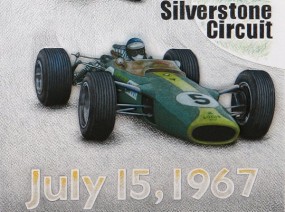Story and photos by Paul Chenard

I’ve always had an interest in 3-dimensional paper sculpture, and 2-dimensional art. In this piece, I combined the 2 art-forms to create a 2D/3D sketch.
I decided to illustrate a “faux” 1967 Silverstone poster, done in the old mid-’60s British style. In the sketch, Clark leads 2nd place finisher Denny Hulme in his Brabham BT24, followed by 3rd place Chris Amon in his Ferrari 312 F1.
As an experiment, I wanted to render a normally 2D sketch into 3D. To create the 3D illusion, I had to illustrate the cars in parts, and then assemble the parts onto the illustrated background.
When you look straight on, it looks relatively normal. But if you lean to one side or the other, the position of everything seems to change. This in called a “trompe l’oeil”, which is French for “trick the eye.”
For example, the Clark Lotus 49 is built from 9 separate illustrations, cut out, and assembled in layers to create this “trompe l’oeil.” If you want to see what is behind the tire, you can actually lean to one side and see what is behind that tire. The 3 cars are done like that, and positioned into their 1st, 2nd, and 3rd race finishing order. The “Silverstone” text is also cut out paper.
1967 Silverstone Poster Recreation – Making 3D out of 2D






Paul Chenard
Through my motor sports artwork, I’m trying to capture the “feeling” that the spectator has watching the race, their favorite driver in battle or the classic racecar at rest.
My favorite drivers are many; I usually have heroes from each period of racing. I love Tazio Nuvolari from the ‘30s for his passion and skill; Juan Manuel Fangio was a shy humble gentleman and artist on the track; Sir Stirling Moss, who could win in whatever he drove; Sir Jack Brabham, with his single-minded push for success as a racer and builder; and of course Gilles Villeneuve, his fearlessness and driving art, nicely summed up at Dijon in 1979.
I live in Halifax, Nova Scotia with my wife, our two sons and a cat.
To see more work from Chenard, visit www.automobiliart.com.










But how did Hulme get that badly crossed up?
Well, David, he didn’t want to run into Jimmy!
Paul…beautiful work. Interesting idea. Congratulations on a job well done.
Cheers!
Greg
Nice work as usual Paul! I’d love to take a closer look. Must have been painstaking work. Cheers, Murray.